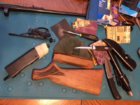Imsinc,
I read that EPA link more carefully once again, and it seems that the EPA controls affect Methylene-Chloride, but NOT "NMP" (N-methylpyrrolidone). I believe that Citristsrip still uses NMP in it, and it has never had Methylene-Chloride in it. The bad review and video I was referring to in my last post about the guy complaining about Citristrip not working was probably because he was trying to strip old lead paint layers off an old piece of furniture. (Citristrip will not work on old lead paint because lead paint removal requires Mehylene-C) However, I'm confused with conflicting accounts from different people working with Citristrip, as more then one person in my google searches stated that Citristrip does remove the Remington BDL epoxy finish. You are saying it doesn't. (??) I'm not looking forward to having to go hunt the controlled MC stuff at Sherwin Williams or other specialty stores and pay ridiculous retail prices, if they even sell it to me. It would be easier to go buy Citristrip at Home Depot. Are you telling me that you have personal experience with the Citristrip and you know that it does NOT work on the BDL finish? I'm not trying to argue with you. I appreciate your help. I'm just trying to sort through the different accounts I've been reading so I know what I'm doing.
Also, if I brush that pressed checkering with a brass bristle brush even just gently, won't it raise the wood a lot, spoil the fine pressed checkering detail, making the wood fuzzy and just ruin it? Or will it dry hard and I can just steelwool the standing fuzz off, and it will look good?
From what I read about that oxyalic stuff; I have to rinse it off good and then neutralize the wood with baking soda before I apply stain? Do I need to do that?















